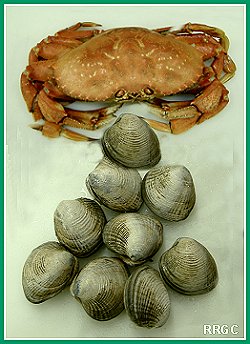Processing Shellfish
Processing Shellfish
Capt. Clark
Sunday December 1st 1805
 The emence Seas and waves which breake on the rocks & Coasts to the S W. & N W roars like an emence fall at a distance, and this roaring has continued ever Since our arrival in the neighbourhood of the Sea Coast which has been 24 days Since we arrived in Sight of the Great Western (for I cannot Say Pacific) Ocian as I have not Seen one pacific day Since my arrival in its vicinity, and its waters are foaming and petially perpetually breake with emenc waves on the Sands and rockey Coasts, tempestous and horiable.
*
Once the shellfish have been transported to their final destination, it is important to check them and determine if they are still alive.
At this point you need to decide when the shellfish will be used. Shellfish is best when it is eaten fresh and If the shellfish will be used within a couple days all you need to do is keep them refrigerated. Place a wet towel over the live shellfish and put them in a location in the refrigerator where cold air will circulate around them.
If you plan on freezing them, crabs should be cooked fully before freezing. Clams, mussels and oysters should be frozen uncooked.
Processing Crab
There are a number of different ways to process crab and the most important first step is to decide how to kill them and whether to clean them before or after boiling in hot water.
Placing the crab directly into boiling water can cause them to shed their legs and retain water in the shell. This is hard on the crab and may also result in tough meat.
Once the crab has been killed it can be placed into boiling water and then cleaned or it can be cleaned before boiling. To clean the crab before or after boiling, pry off the back, break the crab in two , remove the viscera, and pull off the gill filaments.
The are various way to cook crab and any of the following ways are can be used:
After the crabs are cooked, take them from the pot and wash them off with cold water. Remove the meat from the legs and body cavity. The meat can eaten immediately or used in various crab recipes. The freshly cooked crab meat can be kept in a refrigerator for 1-2 days. If the crab meat is to be frozen for later use, do not remove the meat from the legs or body.
If you catch the crabs in a coastal area where there are marinas and commercial fish process facilities there may be a commercial crab cooking pot that can be used for a small fee. An easier way to get good crab meat without going through all of the above steps is to go to a good seafood market and buy crabs that are already boiled. Also most markets will clean the crab for you but you will need to remove the meat from the legs and body.
Processing Clam and Oysters
Processing clams and oysters begins with cleaning the exterior of the shell, removing the meat, cutting out the internal organs and thoroughly washing the meat. Removing the meat from the shell can be done by running a knife along the inner surface of each shell to cut the adductor muscles. Also this may be done by pouring boiling water over the shell until the shells to pop open. This should only take 5-10 seconds; do not soak in boiling water. Remove the meat, slit the neck or siphon, and remove the stomach. The Washington Department of Fish and Wildlife has a website with details on cleaning Razor Clams. After cleaning and washing the meat, it is ready to be used in any of the numerous recipes.
Wash oysters with a strong spray or brush before removing the meat. Use a knife to pry open (shuck) the oyster and collect the meat in a strainer. After the meat is washed and drained it is ready for cooking.
Clams and oysters can be frozen either in their shell or after they have been shucked. Check to be sure the oysters and clams are alive before you freeze them in their shells. If the clams and oysters are shucked, drain the meat and pack in a freezer container leaving 1/2 inch head space. (Note: Freezing will change the texture and flavor of oysters)
|